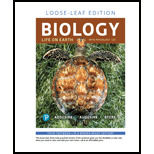
Pearson eText Biology: Life on Earth with Physiology -- Instant Access (Pearson+)
12th Edition
ISBN: 9780135755785
Author: Gerald Audesirk, Teresa Audesirk
Publisher: PEARSON+
expand_more
expand_more
format_list_bulleted
Question
Chapter 3, Problem 5RQ
Summary Introduction
To describe:
The differences between hydrolysis and dehydration synthesis and the examples of substances formed by these reactions and specific reaction in each type.
Introduction:
Biological molecules can be defined as the molecules which are synthesized by living organisms. Almost all the biological molecules are comprised of a carbon atom. As a consequence of the chemical properties of biological molecules, they interact in complex methods. All the biological molecules except lipids are
Expert Solution & Answer
Want to see the full answer?
Check out a sample textbook solution
Students have asked these similar questions
Describe a specific chemical reaction that occurs within the human body and state the name of the enzyme involved, the substrate(s) of the reaction, and the specific product(s) formed.
In 3-4 sentences, define dehydration synthesis and hydrolysis and explain their significance in cells. Be sure to include at least one example of each.
Differentiate enzymes from proteins in detail, in terms of structure and its properties. Please be clear and concise.
Chapter 3 Solutions
Pearson eText Biology: Life on Earth with Physiology -- Instant Access (Pearson+)
Ch. 3.1 - which of these is/are polar molecules? (you may...Ch. 3.1 - define organic molecules and explain why carbon is...Ch. 3.1 - explain why functional groups are important in...Ch. 3.1 - name and describe the properties of seven...Ch. 3.2 - define organic molecules and explain why carbon is...Ch. 3.3 - Describe hydrolysis of this molecule.Ch. 3.3 - describe the major types of carbohydrates?Ch. 3.3 - provide examples of each type of carbohydrate and...Ch. 3.4 - Look up the rest of the amino acids and. based on...Ch. 3.4 - Infectious prions such as those that cause mad cow...
Ch. 3.4 - Why do many proteins, when heated excessively....Ch. 3.4 - Why a Perm Is (Temporarily) Permanent?Ch. 3.4 - describe protein subunits and how proteins are...Ch. 3.4 - explain the four levels of protein structure and...Ch. 3.4 - list several functions of proteins and provide...Ch. 3.4 - Prob. 4CYLCh. 3.5 - describe the general structure of nucleotides?Ch. 3.5 - list three different functions of nucleotides?Ch. 3.5 - explain how nucleic acids are synthesized?Ch. 3.5 - give two examples of nucleic acids and their...Ch. 3.5 - Puzzling Proteins All cells use DNA as a blueprint...Ch. 3.6 - What kind of reaction breaks this molecule apart?Ch. 3.6 - An obese 55-year-old woman consults her physician...Ch. 3.6 - Why are steroid hormones able to diffuse through...Ch. 3.6 - compare and contrast the structure and synthesis...Ch. 3.6 - describe the functions of fats, oils, and waxes?Ch. 3.6 - Prob. 3CYLCh. 3.6 - Prob. 1CTCh. 3 - Polar molecules a. dissolve in lipids. b. are...Ch. 3 - Prob. 2MCCh. 3 - Prob. 3MCCh. 3 - Which of the following is not composed of...Ch. 3 - Prob. 5MCCh. 3 - In organic molecules made of chains of subunits,...Ch. 3 - Prob. 2FIBCh. 3 - Prob. 3FIBCh. 3 - Prob. 4FIBCh. 3 - Fill in the following with the appropriate type of...Ch. 3 - Prob. 1RQCh. 3 - List the four principal classes of biological...Ch. 3 - Prob. 3RQCh. 3 - Prob. 4RQCh. 3 - Prob. 5RQCh. 3 - Describe the synthesis of a protein from amino...Ch. 3 - Where in nature do we find cellulose? Where do we...Ch. 3 - Based on their structure, sketch and explain how...Ch. 3 - Prob. 2ACCh. 3 - Prob. 3AC
Knowledge Booster
Similar questions
- List the four main types of organic compounds found in living systems, and identify which of these are polymer. what compound is used by the body to transfer energy? what role do vitamins play In the cell?arrow_forwardIdentify the following types of biomolecules and label and identify the functional groupsarrow_forwardList five properties of enzymes( biological catalysts).arrow_forward
arrow_back_ios
SEE MORE QUESTIONS
arrow_forward_ios
Recommended textbooks for you
 Biology Today and Tomorrow without Physiology (Mi...BiologyISBN:9781305117396Author:Cecie Starr, Christine Evers, Lisa StarrPublisher:Cengage Learning
Biology Today and Tomorrow without Physiology (Mi...BiologyISBN:9781305117396Author:Cecie Starr, Christine Evers, Lisa StarrPublisher:Cengage Learning

Biology Today and Tomorrow without Physiology (Mi...
Biology
ISBN:9781305117396
Author:Cecie Starr, Christine Evers, Lisa Starr
Publisher:Cengage Learning